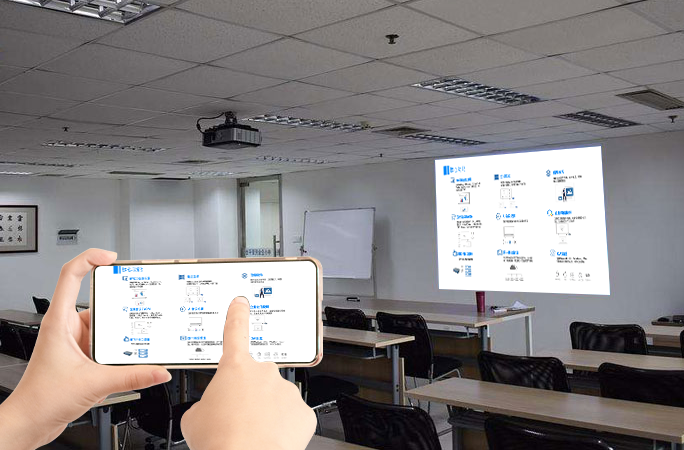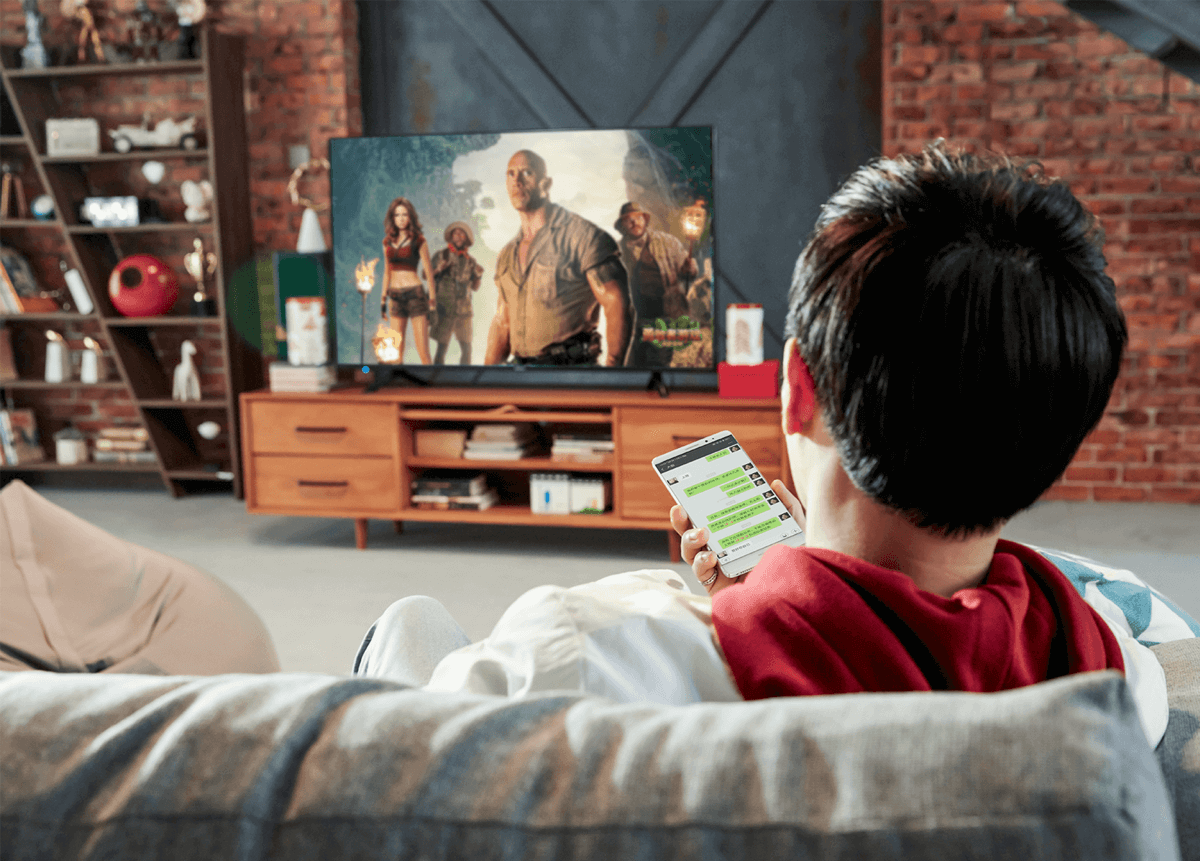Phone Screen Mirroring: Unlocking Efficient Content Flow in Any Scenario
In this age of information overload, our phones are the core carriers of our personal data, storing a vast amount of work documents, life memories, and educational materials. However, their small screen size limits how we can display and interact with this content. Phone screen mirroring technology solves this problem. Through advanced hardware compatibility, optimized protocol support, and customized functions, it enables the stable presentation and efficient interaction of small-screen content on a large screen. Widely used in office, education, home, and commercial settings, it has completely solved the problems of difficult connections, poor compatibility, and bad user experience that traditional screen mirroring faced.
Core Technology: Crossing the Boundaries of Devices and Scenarios
Full Protocol Compatibility, Adapted for All Systems
To achieve seamless integration between phones of different brands and various display devices, we use a multi-protocol fusion architecture that fully supports mainstream mirroring protocols like AirPlay, Miracast, and DLNA. It is also compatible with proprietary brand protocols like Huawei’s Multi-Screen Collaboration and Xiaomi’s Screen Mirroring Assistant, covering all operating systems including iOS, Android, and HarmonyOS. Apple phone users can directly use the “Screen Mirroring” function to recognize the mirroring device, and Android users can simply pull down the control center and tap “Wireless Projection” to complete the pairing. Even for older phones with lower system versions, we provide a backup solution of “QR code mirroring,” where users can scan a QR code on the large screen with a browser to temporarily mirror content in under 3 seconds without needing to enable the system’s mirroring function. The device coverage rate is as high as 99%.
Stable Transmission, Ensuring High-Definition and Smoothness
In terms of transmission performance, the devices are equipped with a dual-band Wi-Fi 6 module and a dynamic frequency hopping algorithm. Even in complex environments with many concurrent devices and signal congestion, they can still maintain 1080P/60fps high-definition transmission, with latency controlled within 50ms. During peak network usage in an office, even if 8 phones are connected and mirroring at the same time, the screen can be switched without lag. In a home setting, while a phone is mirroring a show, a tablet is playing a video, and a computer is transferring files, the large screen playback is still smooth, and the audio-visual synchronization error is less than 20ms, effectively avoiding the awkward “lips don’t match the sound” problem. In addition, it supports 4K ultra-high-definition output, with a color reproduction accuracy of over 95%. It can clearly present the line precision of architectural drawings and the detailed textures of product videos, meeting the strict requirements for image quality in professional scenarios.
Scenario-Specific Hardware Solutions: Customizing a Dedicated Mirroring Experience
Office Scenarios: Improving Meeting Efficiency
- Small conference rooms (5–10 people): Deploy a small, palm-sized desktop mirroring box that easily connects to a conference TV via an HDMI port. It supports the “Tap-to-Mirror” function, where users can automatically complete pairing by simply tapping their phone against the NFC area of the mirroring box, which is especially suitable for fast decision-making meetings. The mirroring box has a built-in microphone, which can capture on-site audio during phone mirroring, eliminating the need for an extra microphone in remote meetings, making it convenient and fast.
- Medium conference rooms (10–30 people): Use an integrated mirroring terminal that combines the mirroring function with touch interaction. After mirroring from a phone, you can directly annotate a PPT on the large screen, and the annotations are synchronized back to the phone in real time. It also supports 4 phones mirroring in a split-screen view. Client data from the marketing department and development progress from the R&D department can be displayed in parallel, increasing decision-making efficiency by 50%.
- Mobile office scenarios: A portable mirroring stick is a great help for people working in the field. It can be used by simply plugging it into a projector’s HDMI port and supports direct connection via a phone’s hotspot, which is suitable for environments with no network. After mirroring a proposal from their phone at a client’s site, field workers can also generate a mirroring record with a watermark for future reference.
Educational Scenarios: Creating an Interactive Classroom
- Regular classrooms: A wall-mounted mirroring terminal is easy to install and can be used after connecting to an interactive whiteboard or a projector. A teacher can film an experiment with their phone and mirror it to the large screen for the whole class to observe. When students submit answers from their phones, excellent answers can be “pinned” for mirroring and display with one tap, which effectively increases classroom participation by 60%. It also supports a “teacher-end lock” function to prevent students from mirroring content at will and disrupting classroom order.
- Outdoor practice classes: A rugged mirroring box has excellent waterproof and dustproof performance with an IP54 rating and can be connected to a portable screen. Students can use their phones to film plant specimens or geological cross-sections. After mirroring, the teacher can use a laser pointer to annotate key points on the large screen, breaking the traditional teaching scene’s reliance on a classroom and making learning scenarios more flexible and diverse.
Home Scenarios: Enabling Entertainment Sharing
- Living room entertainment: A TV with a built-in mirroring module supports “black-screen mirroring,” where you can turn off your phone’s screen after connecting to save power and protect privacy, without affecting the playback on the large screen. It also supports a “picture-in-picture” mode. When mirroring a movie, a small window can display phone messages, allowing users to balance watching with communicating. Parents can also set a “child mode” to limit the duration and type of mirrored content to ensure the child’s healthy use.
- Multi-room linkage: Multi-screen collaboration can be achieved through a home gateway. After mirroring to the living room TV from a phone, you can synchronize the content to the bedroom TV with one tap, with no need to reconnect when switching rooms. It supports a “phone remote control” function, allowing users to adjust the large screen’s volume and switch episodes with their phone, which is more convenient than a traditional remote control.
Commercial Scenarios: Boosting Marketing Displays
- Store displays: A vertical advertising screen paired with a mirroring module allows a salesperson to mirror a 3D product video from their phone. Customers can scan a QR code to save high-definition information on their phones. It supports a “timed mirroring” function, which can automatically loop promotional activities, saving manual labor costs and effectively attracting customer attention.
- Exhibition venues: A rental mirroring terminal has powerful performance and supports up to 100 phones connecting and standing by at the same time. A client can mirror their personalized needs from their phone, and a salesperson can respond in real time on the large screen, which can significantly increase the sales conversion rate by 30%.
Functional Innovation: From One-Way to Two-Way Interaction
Cross-Device Interaction, Enhancing the Collaboration Experience
- Reverse control: The large screen has the ability to directly control the phone. In a meeting, you can use the large screen’s touch function to turn pages of a PPT on your phone and annotate key data. In a classroom, a teacher can grade homework submitted from a student’s phone directly on the large screen, and the changes are synchronized back to the student’s device in real time, enabling efficient interactive teaching and collaboration.
- Content relay: It supports seamlessly switching mirrored content from a phone to a computer for continued editing. After editing is complete, it can be mirrored back to the large screen. This is suitable for multi-device collaboration scenarios. For example, a salesperson can mirror a preliminary proposal from their phone. After returning to the office, they can refine the content on their computer and continue the presentation without needing to re-mirror, which greatly improves work efficiency.
Management and Security, Ensuring Information Safety
- Permission management: In office scenarios, you can set a “whitelist” to allow only specified phones to mirror content. In commercial scenarios, it supports a “temporary mirroring code,” so visitors can only mirror content after entering a verification code, which effectively avoids information leakage and ensures information security.
- Mirroring records: The system automatically saves mirrored content, time, and device information. This can be used to trace meeting content in office scenarios, review classes after they’re over in educational scenarios, and analyze which products customers are interested in for future decision-making in commercial scenarios.
Value Creation: Improving Efficiency and Experience
After a certain internet company implemented this solution, their meeting preparation time was drastically shortened from 15 minutes to 1 minute, and cross-departmental communication efficiency was increased by 40%. After a middle school introduced the classroom mirroring solution, student homework submission efficiency was increased by 70%, and teacher grading time was reduced by 50%. After a certain retail chain adopted the marketing mirroring solution, customer dwell time was increased by 30%, and the average transaction value was increased by 25%.
The core of the phone mirroring solution is to allow “small-screen content” to deliver maximum value in a “large-screen scenario.” It is not just a technological integration but a precise response to the needs of different scenarios. Through hardware adaptation, functional innovation, and security guarantees, every mirroring session becomes a starting point for improving efficiency, ultimately maximizing the value of “small-screen content on a big screen.”